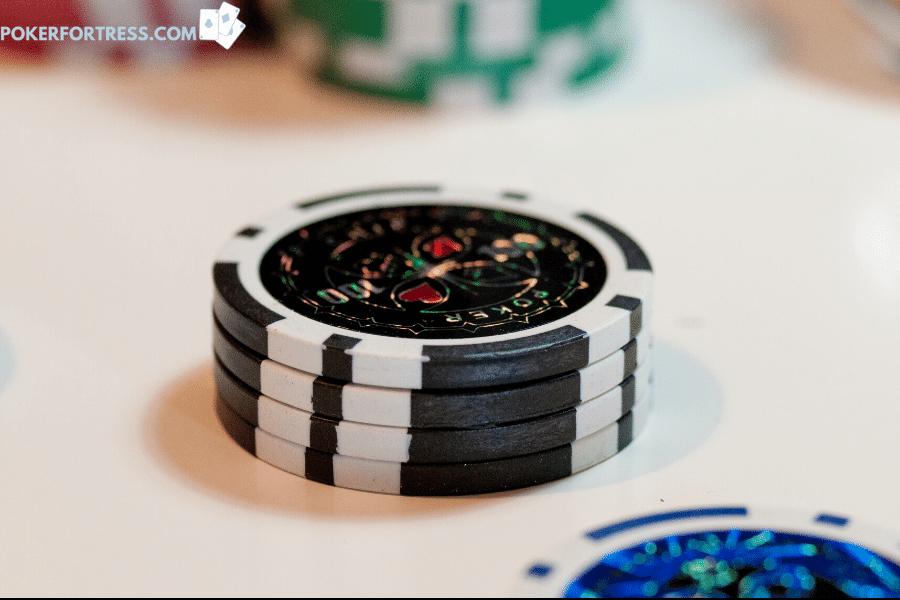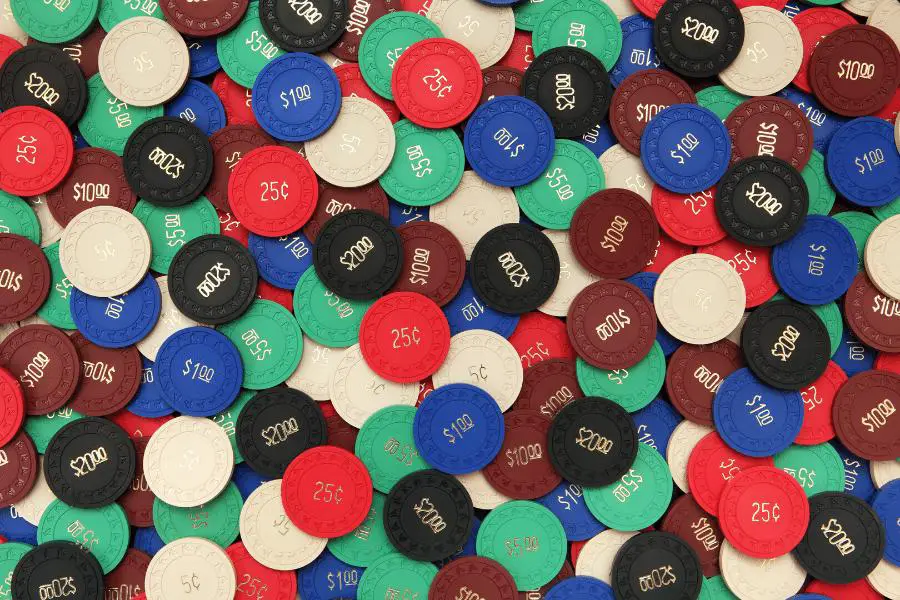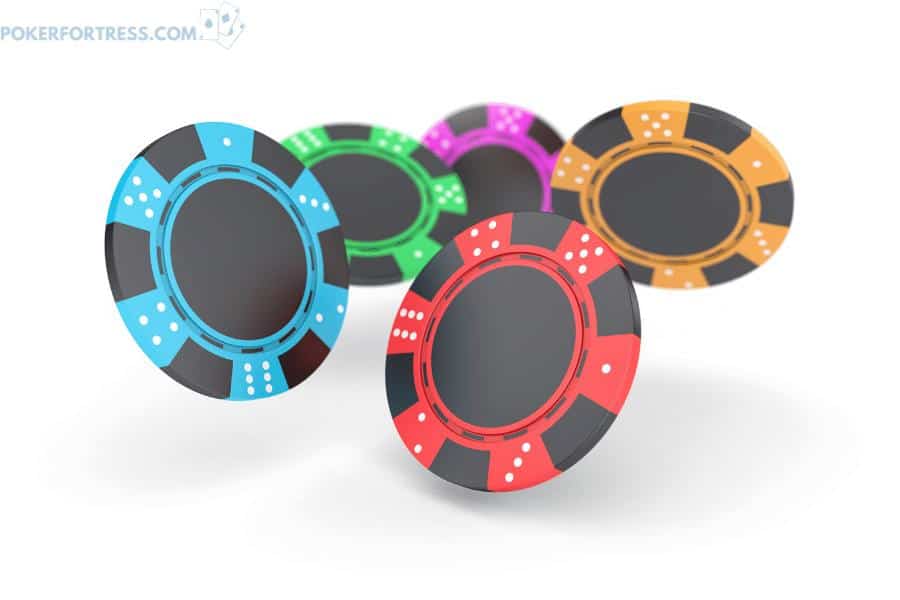If you want to create an authentic poker room feel for your home poker games, choosing the right poker chip is crucial. But, it’s confusing trying to work out the differences between the array of poker chips available. In the end, getting that authentic feel depends on what the poker chips are made of.
Poker chips are made of a variety of different materials. In general, poker chips used in casinos are predominantly clay, with sand, chalk, and other additives. Some casinos use ceramic poker chips, which are a hard, dense polymer.
If it seems like there’s no limit to your confusion, don’t worry. Let’s turn that around now by going through in more detail the different materials used in the making of poker chips.

Clay Poker Chips
If you’re looking for poker chips of the type traditionally used in casinos, then you’re talking about clay poker chips. But, let’s be clear, it’s decades since poker chips were crafted from 100% clay.
Clay Poker Chips Aren’t All Clay?
That’s right. The modern clay poker chip is a mixture of clay, plus, sand, and chalk. These and other additives make the clay less brittle and increase durability. If chips were 100% clay, they’d damage easily or even snap in two.
So, in modern parlance, a clay poker chip isn’t entirely made of clay. But, they’re still called clay chips.
They’ll be predominantly clay, but with other elements added for strength. So, we’ll talk about them as clay chips as it’s a convenient way to distinguish them from other types of chips.
Generally, the best-known examples of clay poker chips are those made by Gaming Partners International Corporation under the Paulson name. But, it no longer produces for the retail market, only for casinos.
You can pick up Paulson chips on the second-hand market. An example is this $5 Binions Las Vegas chip, which bears the famous top hat and cane mold used by Paulson.
Other times, you can grab some when a casino changes its name or branding. Then their current chips become obsolete and are often offered for sale.
As the guy in this video explains, you have to keep an eye on poker chip forums to stay abreast of what’s available.
The Paulson clay chips seem to be the royal flush in the hierarchy of poker chips. So, they’re the standard by which many people judge all other poker chips. That happens even when you get down to plastic poker chips, as you’ll see later.
How Are Clay Poker Chips Made?
The production of clay chips uses a process called compression molding. It’s a process that uses high pressure and heat to achieve the desired shape and design.
Briefly, the base-colored clay disc goes into the bottom heated mold cavity, and then the top of the mold is forced down onto it. The pressure compresses the mix into all areas of the mold. That way, when set, the mixture takes on the detailed mold pattern.
The mold pattern includes the fancy embossing around the outer edges of many poker chips.
The trickier parts of the process are the inlay and the inserts or edge spots. Dealing with these aspects of the clay poker chip is where the costs really come in.
The inlay is the center of the chip, where you’ll see some sort of branding or design. Often, it also displays the denomination of the chip.
The inserts or edge spots appear as stripes on the chip surface. They’re the lines or blocks of color that encircle the inlay and extend over the chip’s edges.
The inlay is paper, so it’s covered with a thin layer of plastic to provide durability. It’s then inserted into the mold before compression so that it forms part of the chip. That means you can’t peel it off.
The edge spots are sections of clay cut out from around the edges of the disc. The manufacturer then inserts the desired color of clay into the cut out areas to form the edge spots.
So, as you can see, making clay poker chips of the type you find in the casinos is an involved process. Part of the process is labor-intensive. But this process is what gives the chips their look and feel.
How to Tell if Your Chips Are Clay Chips

There’s a lot of confusion around this. It’s not helpful that product descriptions always seem to refer to chips as clay or clay composites.
You may have noticed this yourself. For example, seeing a retailer describe plastic chips as clay composite chips. Now, there may be some clay in those chips, but if so, it’s probably a smidge. So don’t fall for the bluff. Call or raise them on it.
Better still, be aware that this happens and know the tells. Some pointers are:
- Price per chip. Check what you’re paying. If it’s not at least $1 a chip, you can pretty much guarantee that the chip isn’t predominantly clay. That’s not to say there’s no clay in it. It’s just that it’s more likely to be only a small proportion of the materials used. Due to the production process, a compression-molded chip that is predominantly clay is expensive.
- Chip weight. Casinos tend to use chips weighing between 8 and 10g (0.3 to 0.35oz). Most lower-end chips are heavier, probably between 11 to 14g (0.39 to 0.49oz). Now, it’s not always the case as there are decent composite and plastic chips available at around 9g (0,32oz). So, check other factors.
- Chip diameter. Most casinos use 39mm (1.53’’) diameter chips. Some lower-end chips are about 43mm (1.69’’). Again, this isn’t conclusive.
- The sound chips make when you shuffle them. It’s hard to describe the sound that clay chips make. You could say that it’s a distinctive clacking. Of course, all chips will clack when you shuffle them. But with the casino clay chips, it’s probably a deeper or a more solid sound than you get from other materials. Cheaper plastic, for example, might sound more like an irritating high-pitched tweet.
- The inlay. Clay chips have the inlay sealed into the chip during the production process, so you can’t peel it off. There may only be a sticker on cheaper chips, so you’ll be able to peel it off. The sealing of the inlay into the fabric of the clay chip also means the colors won’t bleed if they get wet. So, you can wash the chips without distorting the graphics on the inlay. Thus, bleeding colors may suggest your chip isn’t clay.
- The mold. Expect to see some imperfections in a compression molded clay chip. For example, the delineation between the edge spots and the chip’s base color may not be sharp or precise. That’s part of the character of clay chips. As you’ll see later, however, some cheaper chips try to mimic this effect.
- The texture. Genuine clay chips shouldn’t feel slippery when you handle them. There should be a bit of texture, giving you some grip.
China Clay or Clay Composite Poker Chips
China clay is kaolin, a type of clay that is soft and white, and usually found in China. You’ll often find it in porcelain products. When mixed with water, at around 25 to 35%, it becomes like a plastic. This means you can then mold and shape it.
More Confusion in Nomenclature
China clay chips are also known as clay composite chips. That’s because there’ll be additives in the mix to strengthen and provide extra weight. So, again, we’re talking about a composite material, not pure China clay.
You may even see them described as clay chips. Again, not helpful.
It gets even more confusing when you see some plastic chips described as clay composites, but we’ll get to that later.
How to Tell if It’s China Clay?
China clay chips should have a slightly dusty feel, which you won’t get from plastic chips.
Poker chips made from China clay can be similar in look, feel, and sound to the clay chips detailed above. So, they’re an excellent alternative for clay chips.
The advantage is they’re considerably cheaper than clay chips. We’ll look at why next.
The Production Process for China Clay Chips
Not surprisingly, these chips are mass-produced in China.
Some of these chips may have the term compression molded in their description. But, it’s probably not the same method used for clay chips.
Their production process is perhaps a multi-shot injection molding process to get the multiple colors on the chip.
It’s a more efficient way than the type of compression molding used for clay chips.
With injection-based molding, the filling of the mold is by continuous injection, not manual. So it’s less labor-intensive and cheaper. You can see the multi-shot process in this video.
On a China clay chip, what’s called the inlay is usually just a sticker or label attached with adhesive. This distinguishes them from clay chips produced by compression molding.
Unlike most plastic chips, the China clay chips don’t have a metal insert or slug inside. So, they mimic more closely the weight that you’ll find in casino clay chips, around 10g.
If you’re looking to emulate the authentic casino experience but don’t have the budget for casino clay chips, China clay chips will do the job. They’re significantly cheaper than the clay chips, usually around the 50c level, give or take.
A well-known example of a China clay poker chip that’s been around for a while is the Milano 10g Poker Chip by Claysmith Gaming.
This video gives a lengthy review of the Milano chip. It’s a good watch if you like what you see but want to know more before splashing your dollars into the pot.
Here’s a detailed review of various China clay chips in general. It’s worth viewing if you’re considering buying a set of this type. It gives you some good points and some bad points about this kind of chip.
Ceramic Poker Chips
Contrary to the name, ceramic poker chips aren’t actually ceramic. They’re a hardened plastic or resin material, perhaps a bit like bakelite.
The material is a polymer composite. It’s the material’s high-density composition that gives ceramic chips their hardness. It’s also what makes them feel and sound like ceramics, hence the name.
How Are Ceramic Chips Made?
The production process for ceramic chips is injection molding. It’s a less complicated form than the process described above for clay composite chips. That’s because the base of a ceramic chip is a single color, usually white.
The process takes melted beads or pellets of the polymer composite and injects them into the desired mold. You can see how the process works in this short video.
Once you have the blank chip, a form of digital printing known as dye-sublimation transfers the design onto the chip, so you print directly onto the chip. This eliminates the need for separate labels or inlays.
Additionally, the method allows the design to cover the whole surface area of the chip. The process also allows for more vivid colors and intricate designs.
So, ceramic chips lend themselves to customization. Probably because of the unlimited design potential, as well as durability, ceramic chips are in use in some casinos.
What Do Ceramic Chips Look Like?
These Nevada Jack 10g ceramic chips are a good example of this type of chip.
You can see that unlike clay and China clay chips, ceramic chips tend to have a flat surface. There’s no need for a center indent because there’s no label or inlay. The flat surface helps with the printing process.
But it also means some ceramic chips may be overly smooth and slippery, whether you like that is down to personal choice. The problem is, if they’re too smooth, chips are prone to sliding around and slipping off your stack.
The Nevada Jack chips have a slightly linen-textured surface, so they’re less prone to slipping. The texture also makes them pleasing to handle.
It’s worth getting samples of any designs that you like before choosing if the smoothness is an issue.
Ceramic chips are often pricier than the China clay option, but cheaper than the authentic clay chips. Still, they’re more durable, so you may get more play out of them than a China clay chip. Expect to pay around 60c to 70c per chip.
Plastic Poker Chips

Plastic poker chips are precisely that, plastic. They’re at the lower end of the price range. That makes them useful if you need a large number of chips, but your budget is tight.
The Cheap as Chips Poker Chips
Plastic chips are significantly cheaper than the other types of chips discussed above.
The cheapest, like this set of 160 Plastic Poker Chips, mark the bottom of the price range. But, you’re not going to want to whip these out if you’re playing with even mildly serious poker players. Well, other than as a bluff.
You can get plastic chips above this basic level, which look more like a poker chip.
Some, like these Brybelly Super Diamond Poker Chips, are a similar weight to casino chips.
But, like these Da Vinci Dice Striped Poker Chips, others might have a metal insert or slug to add weight. The slugged chips often weigh more than real casino chips, sometimes coming in at about 14g (0.49oz). Some players like this or don’t mind, while some don’t like it at all.
Plastic Chips With Authenticity

Surprisingly, you can get something much more realistic in plastic that won’t break the bank.
The Nextgen Pro Classic is a plastic chip that tries to replicate the look and feel of a genuine casino chip. The advertising spiel refers to a unique manufacturing process used to achieve this.
On looks, they try to mimic the classic Paulson clay chips, even down to imperfect lines of the edge spots mentioned above.
They also feel like clay chips when you handle them because of some added texture. So, they’re not slippery, contrary to what you’d expect from a plastic chip.
Weight-wise, at about 9g (0.32oz), they’re the typical weight that you find in casinos. Unlike most plastic poker chips, the Nexgen Pro Classic chips are metal slug-free. So they sound less clunky when you shuffle them. The sound is reasonably close to that of the clay chips.
They seem to do a good job of imitating the clay casino chips, as you can see from this review. So, clearly, the manufacturer is doing something right.
Conclusion
As you can see, what are poker chips made of has several answers.
You’ll find the more expensive end of the range dominated by clay, clay composites, and ceramic chips. While at the cheaper end, you’ll find a variety of plastics.
The best way to decide which to choose is to get samples of ones that interest you and compare them in the flesh. It’s only through seeing them up-close and handling them that you’ll be able to make an informed choice,
Which material you choose is down to personal preference, as well as budget. But, with the range of choices available, the odds of finding something to suit are stacked in your favor.



